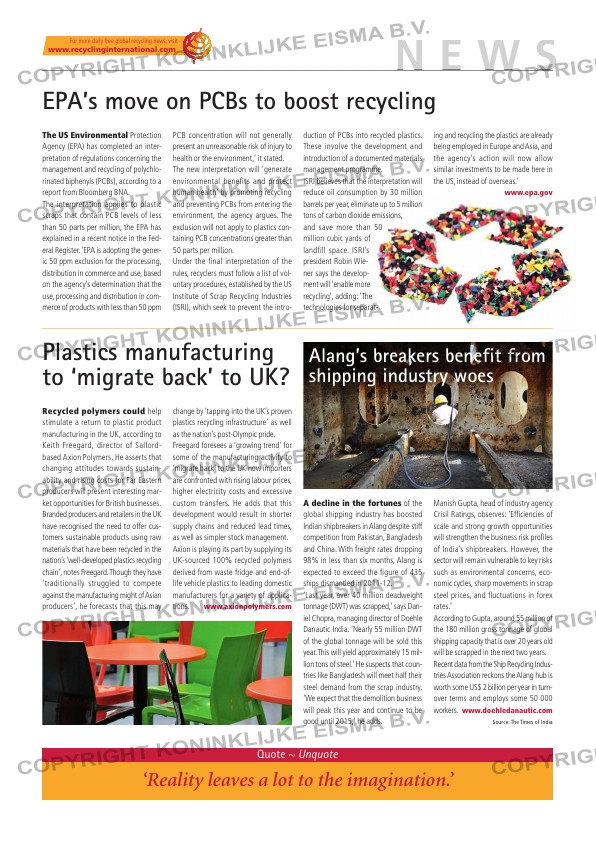Page 19 from: May 2013

N E W S
‘Reality leaves a lot to the imagination.’
Quote ~ Unquote
For more daily free global recycling news, visit
www.recyclinginternational.com
The US Environmental Protection
Agency (EPA) has completed an inter-
pretation of regulations concerning the
management and recycling of polychlo-
rinated biphenyls (PCBs), according to a
report from Bloomberg BNA.
The interpretation applies to plastic
scraps that contain PCB levels of less
than 50 parts per million, the EPA has
explained in a recent notice in the Fed-
eral Register. ‘EPA is adopting the gener-
ic 50 ppm exclusion for the processing,
distribution in commerce and use, based
on the agency’s determination that the
use, processing and distribution in com-
merce of products with less than 50 ppm
PCB concentration will not generally
present an unreasonable risk of injury to
health or the environment,’ it stated.
The new interpretation will ‘generate
environmental benefits and protect
human health’ by promoting recycling
and preventing PCBs from entering the
environment, the agency argues. The
exclusion will not apply to plastics con-
taining PCB concentrations greater than
50 parts per million.
Under the final interpretation of the
rules, recyclers must follow a list of vol-
untary procedures, established by the US
Institute of Scrap Recycling Industries
(ISRI), which seek to prevent the intro-
duction of PCBs into recycled plastics.
These involve the development and
introduction of a documented materials
management programme.
ISRI believes that the interpretation will
reduce oil consumption by 30 million
barrels per year, eliminate up to 5 million
tons of carbon dioxide emissions,
and save more than 50
million cubic yards of
landfill space. ISRI’s
president Robin Wie-
ner says the develop-
ment will ‘enable more
recycling’, adding: ‘The
technologies for separat-
ing and recycling the plastics are already
being employed in Europe and Asia, and
the agency’s action will now allow
similar investments to be made here in
the US, instead of overseas.’
www.epa.gov
EPA’s move on PCBs to boost recycling
Recycled polymers could help
stimulate a return to plastic product
manufacturing in the UK, according to
Keith Freegard, director of Salford-
based Axion Polymers. He asserts that
changing attitudes towards sustain-
ability and rising costs for Far Eastern
producers will present interesting mar-
ket opportunities for British businesses.
Branded producers and retailers in the UK
have recognised the need to offer cus-
tomers sustainable products using raw
materials that have been recycled in the
nation’s ‘well-developed plastics recycling
chain’, notes Freegard. Though they have
‘traditionally struggled to compete
against the manufacturing might of Asian
producers’, he forecasts that this may
change by ‘tapping into the UK’s proven
plastics recycling infrastructure’ as well
as the nation’s post-Olympic pride.
Freegard foresees a ‘growing trend’ for
some of the manufacturing activity to
‘migrate back’ to the UK now importers
are confronted with rising labour prices,
higher electricity costs and excessive
custom transfers. He adds that this
development would result in shorter
supply chains and reduced lead times,
as well as simpler stock management.
Axion is playing its part by supplying its
UK-sourced 100% recycled polymers
derived from waste fridge and end-of-
life vehicle plastics to leading domestic
manufacturers for a variety of applica-
tions. www.axionpolymers.com
Plastics manufacturing
to ‘migrate back’ to UK?
A decline in the fortunes of the
global shipping industry has boosted
Indian shipbreakers in Alang despite stiff
competition from Pakistan, Bangladesh
and China. With freight rates dropping
98% in less than six months, Alang is
expected to exceed the fi gure of 435
ships dismantled in 2011-12.
‘Last year, over 40 million deadweight
tonnage (DWT) was scrapped,’ says Dan-
iel Chopra, managing director of Doehle
Danautic India. ‘Nearly 55 million DWT
of the global tonnage will be sold this
year. This will yield approximately 15 mil-
lion tons of steel.’ He suspects that coun-
tries like Bangladesh will meet half their
steel demand from the scrap industry.
‘We expect that the demolition business
will peak this year and continue to be
good until 2015,’ he adds.
Manish Gupta, head of industry agency
Crisil Ratings, observes: ‘Effi ciencies of
scale and strong growth opportunities
will strengthen the business risk profi les
of India’s shipbreakers. However, the
sector will remain vulnerable to key risks
such as environmental concerns, eco-
nomic cycles, sharp movements in scrap
steel prices, and fl uctuations in forex
rates.’
According to Gupta, around 55 million of
the 180 million gross tonnage of global
shipping capacity that is over 20 years old
will be scrapped in the next two years.
Recent data from the Ship Recycling Indus-
tries Association reckons the Alang hub is
worth some US$ 2 billion per year in turn-
over terms and employs some 50 000
workers. www.doehledanautic.com
Source: The Times of India
Alang’s breakers benefit from
shipping industry woes
RI-4_NEWS.indd 19 03-05-13 13:42



